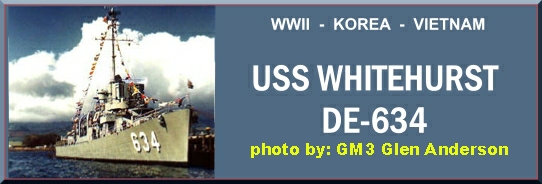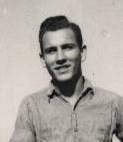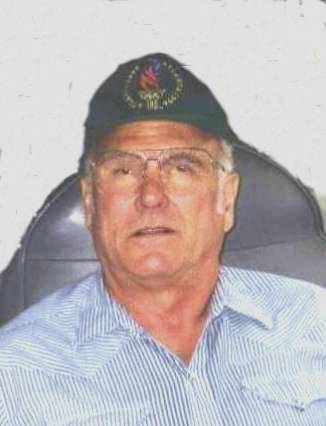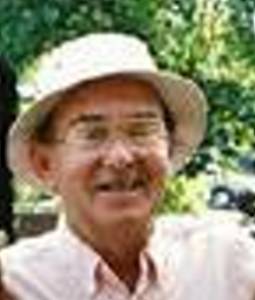
USS Whitehurst Logo by: Pat Stephens, Webmaster, DESA
|
Memories of Pusan and Archie the Korean Rabbit |
|
By Al Crawford QM1 on Whitehurst now QMCM USN Ret. |
|
|
|
Site Author's note. The essential facts presented here are true. There are some embellishments in the Rabbit Story but even those could be true. Please accept this entertaining story as it was written, tic, with good will. mc |
|
The USS Whitehurst (DE-634), a unit of
DesRon 32, during the Korean Conflict, was sitting alongside Pier 4
in Pusan, Korea, during the month of June 1951. In fact she
had been sitting in exactly the same spot for over five months. The Whitehurst was converted to a Floating Power Plant at Pearl Harbor in May-June 1945; following extensive battle damage and loss of life, while serving as a screening vessel during the landings at Okinawa. The other ships in our squadron that were similarly converted were the USS Foss (DE-59), USS Wiseman (DE-667), and USS Marsh (DE-669). We were supplying electric power to the South Korean Power Company. The need for the Whitehurst and other units of DesRon 32, doing similar duty in other South Korean ports, was created when the Chinese entered the war on the side of the North Koreans, and captured the hydro-electric power stations on dams in North Korea which supplied electric power to the South. Now in certain ports, a nice pier side stay would be heaven, but in Pusan, Korea it was pure hell. To get to the city from our berth we had to walk through an area of sunken concrete curing pits containing "night soil." Tank trucks (honey dippers) toured the city picking up human waste, and opened a valve on the rear of the truck to fill the pits. After curing for a period of time, it was removed and used for fertilizer. When the wind was blowing off the land we were almost asphyxiated. This duty was like living in the head. We would eat our meals holding our noses, as frankly the smell permeated everything. When we complained up the chain of command, the skipper contacted the Division Doctor who visited our ship. He gave an all hands talk, and rewarded us with the knowledge that, "You can't catch any disease from smell." Many of the crew including myself had come down with dysentery. This is an intestinal inflammation, with severe abdominal pain, frequent and intense diarrhea, and you don't really want to hear the rest. When hit with this illness the only relief was to lie in the bunk in a fetal position. Pulling your knees up to the chest seemed to reduce the pain somewhat. I can't remember if we were medicated for this or not. Perhaps it just had to run its course. These are the conditions we had to work, eat and sleep under. The doctors informed us that we were getting dysentery from the dust blowing off the land which we were breathing. Flies walking on the ground would deposit the dysentery bugs and the airborne dust would reach our ship. We had to put double layers of cheesecloth over all the ventilators that sucked air to below deck spaces. We were told never to touch our hands to our faces except after washing., Doing this did cut down the dysentery. Most men had to make only one liberty, before voluntarily confining themselves to the ship, and club house. Other men hearing of conditions in town never made a liberty. We were told not to eat any food, as it was grown in night soil and probably contaminated, and some of the liquor was lethal, made with wood alcohol Now to keep the entire crew from going "ape," a recreation program was started, and everyone was encouraged to get involved in as many activities as possible. Most of this took place in a club house that was erected on the pier just across from the ship. The building was about 20 x 40 feet, and made of solid Philippine mahogany. It was used for boxing instructions in the afternoon, and bingo, card playing, and board games in the evening. At the time I was 25 years-old, 6' 2" tall and weighed 225. I had done a little boxing a few years earlier in WWII. QM3 Roy Bilck had been quite a boxer before joining the Navy, and he offered to teach boxing. I being a slugger, thought I could gain a little finesse so I went to a session for instruction. I sparred a little with Bilck, while he analyzed my style, then he told me to lay one on his chin. I refused saying, "I don't want to hurt you." His reply was, "Go ahead, throw your best punch. You won't be able to touch me." Well he was fast, and he weaved and bobbed and was ducking my punches. In short order, I faked a left, and broke his nose with a follow-up right. To this day, I'm not sure who learned a lesson. We were rationed to two cans of beer per day, and were issued tickets each good for one can of beer. The beer had to be consumed in the club house on the pier, no alcoholic beverages being allowed aboard a Navy ship. The real beer drinkers would either purchase the tickets from a nondrinker, or give their tickets to a shipmate so that they would go a few days without any beer, and end up on the third day with six cans, etc. This way we had some rip roaring bingo games. The whole object here was to keep the crew from going "ape."
The one man on the ship who could not
let his hair down and get in the swing of things, was our Commanding
Officer, LCDR Malcolm G. Evans. Being the skipper, and above mixing with
the enlisted crew, he kept pretty much to his cabin. What mixing he did
was of course with the other officers. A recent phone call with our XO Art
Hammarlund, tells me that they played cards in the wardroom almost every
evening, except Evans would not play on Sunday. Another officer
interviewed for this article tells me that Evans was not above cheating at
cards, just a little. Addendum by Al Crawford, Oct, 2002:
I've been talking by phone with Hugh
Toney, and he called me today. We talked about a lot of things, and like a
bolt out of the blue, I thought about something I had never thought of before. |
|
Hugh Toney's Memory of the Incident |
|
|
|
Hugh Toney BT3 remembers:
Captain Evans was really pissed. He put everyone on restriction saying,
"There'll be no liberty until the one who killed the rabbit comes
forward." No one came forward and no one had any liberty for, as I
remember, almost a month. This was devastating to the morale of the
crew. Finally the restriction was lifted. There was a hospital ship
in the harbor at the time. Although I have no proof, I've always believed
that Chief Hospitalman Mitchell and HM3 "Doc" Brown must have reported
the situation to some high ranking naval officer on the hospital ship, who
exercised some influence over Evans, causing him to lift the restriction. |
|
|
|
Jack Farmer was the Ship's Carpenter |
|
|
|
|
|
Jack Farmer DCW2 remembers: It
was Sunday morning. (We were allowed to skip breakfast and sleep in on
Sundays). A messenger came to my bunk and woke me, saying, "Cap'n
Evans wants you to get up and build a rabbit cage for him." Well I
must have been half asleep because I said he could tell the captain that if he
wanted a rabbit cage he could build it himself. I turned over and
went back to sleep. The messenger apparently went back and told the
captain exactly what I'd said because Bill Watson, the Damage Control Officer,
came to my bunk and said, "You'd better get up and do what the captain
asked." So I built the cage and it was put up on the 02 level where
all the electrical cables and transformers were. I don't know anything
about the rabbit being tossed over board. I've always thought it got into
the electrical gear and was electrocuted. |
WWII Era | Korea War & '50s | Viet Nam & 60s | Reunions | All Links Page Search & Rescue
Memorial | Poetry | Enemy Below | Taps List | Photos/Armament | History | Crews Index | Home



